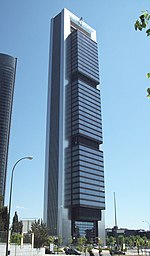Caja Madrid
| Caja de Ahorros y Monte de Piedad de Madrid | |
|---|---|
 The Torre Caja Madrid , headquarters of the Caja Madrid |
|
| Country |
|
| Seat | Plaza de Celenque, 2 28013 Madrid |
| legal form | Corporation |
| founding | December 3, 1702 |
| management | |
| Corporate management |
Miguel Blesa de la Parra |
Caja de Ahorros y Monte de Piedad de Madrid was the oldest Spanish savings bank and was founded on December 3, 1702. The fourth largest Spanish financial services provider was known under the short name Caja Madrid until 2011. In 2005, 12,731 people were employed and 1,940 domestic branches were operated. In addition, banking was carried out in 330 branches of the Mapfre Group, with which there was close cooperation and mutual capital participation . Foreign branches existed in Miami, Lisbon and Dublin. According to its own information, Caja Madrid looked after 6.7 million customers, from private individuals to corporations, and had total assets of 180.716 billion euros for 2005 .
In December 2010, Caja Madrid merged with six other Spanish savings banks to form Bankia . In mid-2011 the name “Caja Madrid” was replaced by “Bankia”.
Spain supported Bankia in 2012 with 24 billion euros. In October 2014 it became known that a credit card scandal was being investigated against former directors of the Caja Madrid .
history
The beginnings
The Spanish savings banks developed from the Franciscan poor relief institutions , the so-called Monte de Piedad (Eng. Mountain of Mercy), which were set up in Spain in the 18th century, coming from Italy. The Monte de Piedad in Madrid was the first of its kind in Spain. Interest-free loans were granted to the needy against collateral such as jewelry or clothing. In this way, usury rates could be avoided. The work of the various Monte de Piedad active in Spain was financed through donations , allocations from the royal family and the church, and income from the mining of precious metals .
The savings bank
From 1836, interest was charged on the loans for the first time to cover the administrative costs of Monte de Piedad and to secure its future. By royal decree of October 25, 1838, the Caja de Ahorros de Madrid (Savings Bank of Madrid) was founded. For the first time, deposits were accepted that earned interest.
Caja de Ahorros y Monte de Piedad de Madrid
Despite the close ties, the two institutions initially remained independent. However, the mutual financial dependency led to a de facto amalgamation over time. The final legal merger took place on April 22, 1869. If the new institute was called Monte de Piedad y Caja de Ahorros de Madrid at the beginning, the name components were soon changed according to their meaning. The charitable origin was pushed back. However, Caja Madrid still supports various projects today (as of 2005) through its social work. In 2005, 161 million euros were spent on cultural and social tasks.
Financial investments
Caja Madrid holds numerous investments in Spanish groups such as Mapfre , Indra , Iberia and NH Hoteles . Caja Madrid also owned a 10% stake in Endesa . After the announcement of the intention to sell in January 2007, various prospective buyers contested the purchase of this share. After E.ON from Düsseldorf withdrew , the stake was sold to the Spanish Acciona and the Italian Enel .
politics
Politically, Caja Madrid is considered to be close to the conservative Spanish People's Party (PP) , while its main competitor “ la Caixa ” from Barcelona is dominated by the Spanish Socialists (PSOE) .
Others
In 2007 a real estate bubble burst in Spain . Banks had contributed to this through their lending practices. Since the bubble burst, many Spanish banks have had bad loans on their books because debtors cannot service their loans and the real estate pledged as collateral is unsaleable or can only be sold well below its value.
In 2009, Spain (like many other industrialized countries and euro countries) suffered from an economic crisis (see financial crisis from 2007 and euro crisis # Spain ).
